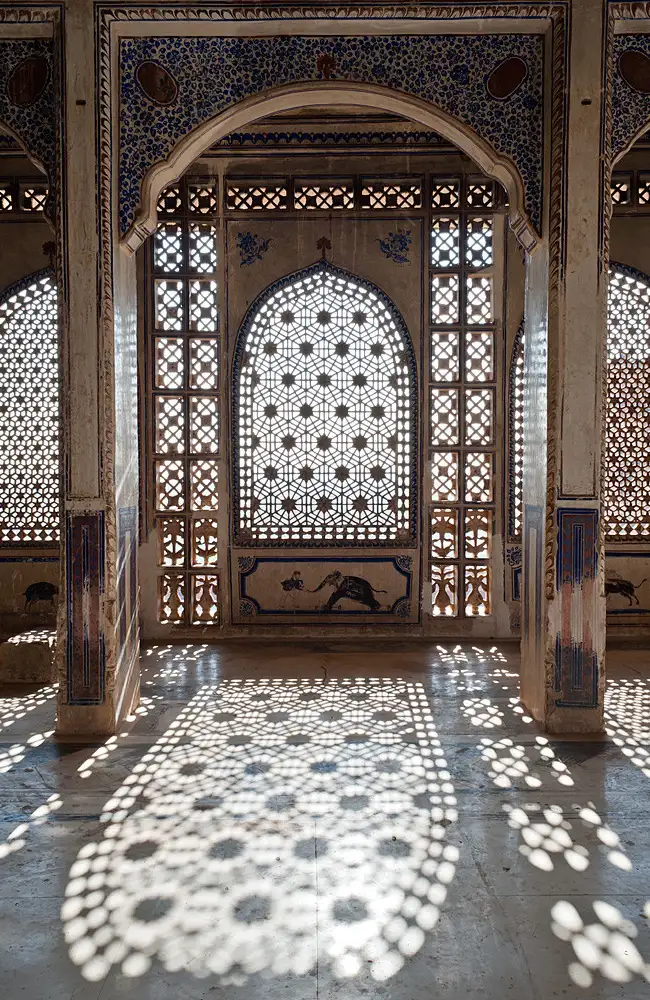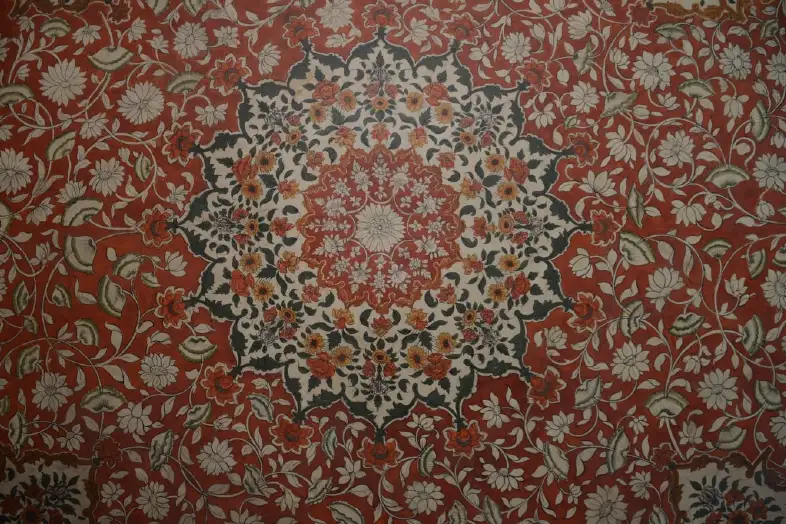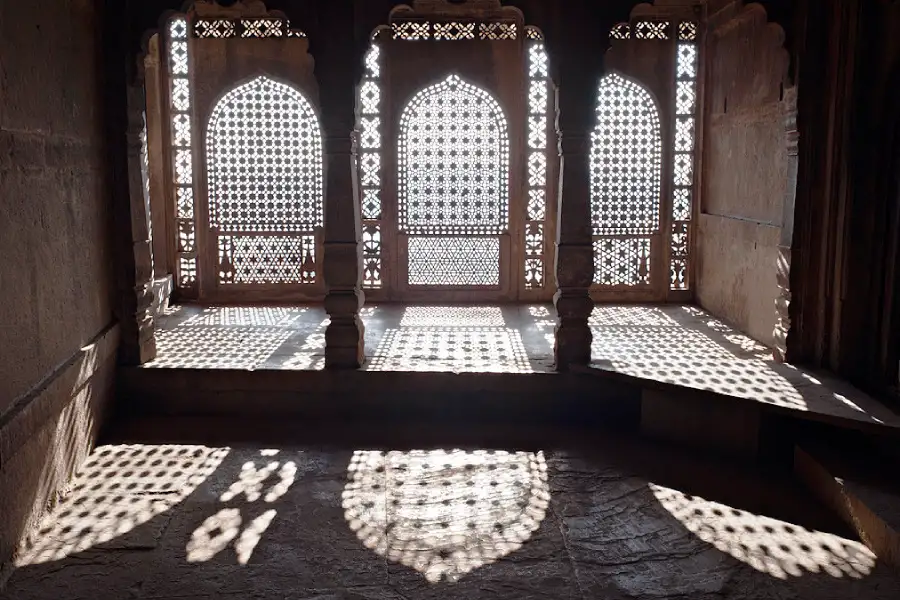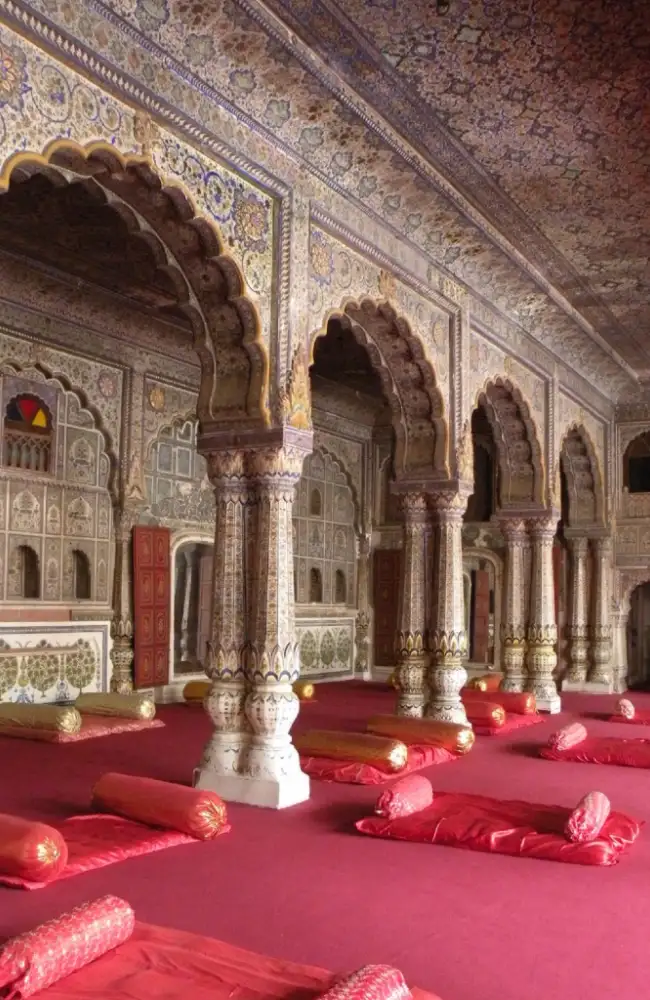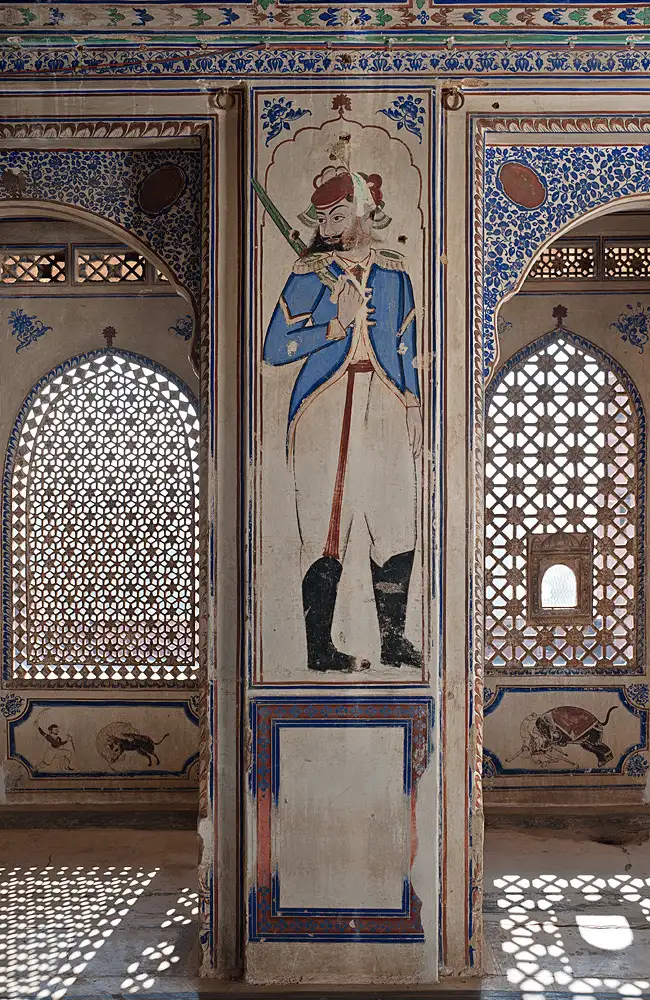
Art Tour
Bhanwar Vilas Palace invites artists, photographers, connoisseurs and art lovers for specialized art tours in Karauli, with the guidance of Yuvraj Vivasvat Pal, an artist and collector. The ancient town of Karauli was established in 1348, though its royal family actually pre-dates Rajput history itself, having had several capitals including Mathura before settling in Karauli. Karauli developed a distinct school of miniature paintings; different even from the Hadoti school of its nearest geographical neighbours, Bundi and Kota. Its traditional exponents were hereditary artists known as chateras who flourished under the patronage of the royal family. The tour covers a wide range of styles and objects from archaeological finds in the area, miniatures of the Karauli school, frescoes, carvings, and architecture of the unique Indian Art Deco style.
Your residence for the tour will be Bhanwar Vilas Palace. Built by Maharaja Ganesh Pal, in 1938 and its unique architecture and interiors that veer from Bauhaus to Colonial were quite avante garde. Stylistically, it rather resembles an English country house in its eclectic yet harmonious melding of Oriental and Art Deco forms. Gothic style archways, rest upon stone pillars with carved with plump figures of pigeons and roosters, as they surround the very Indian enormous courtyards. While bird motifs are seen occasionally in Indian carvings they are usually highly exaggerated and stylized unlike the realistic carvings in Bhanwar Vilas. The Art Deco mosaic flooring is an artwork in itself, with completely unique patterns in every room. Bhanwar Vilas is very unique in that none of the rooms are newly constructed, they are all part of the original edifice and with antique furniture in each room to present an authentic, and not merely simulated, heritage experience. Maharaja Krishna Chandra Pal and Maharani Rohini Kumari undertook the conversion of Bhanwar Vilas into aheritage hotel in 1992 restoring and decorating its period interiors, the Lalique Maharaja Krishna Chandra Pal and Maharani Rohini Kumari undertook the conversion of Bhanwar Vilas into aheritage hotel in 1992 restoring and decorating its period interiors, the Lalique lights, exquisite European tapestries, portraits and furniture in a completely authentic manner while modernising its luxuries.
The 14th century city palace, the former residence of the rulers, stands in the middle of the ancient walled city which retains a lot of its historical charm with winding lanes and handicraft shops. The Palace itself is an overwhelming experience, from the first sight of its towering stone gate adorned with fine Krishna paintings. This mammoth symbol of architectural perfection has remarkably fine miniature paintings in almost every one of its many rooms, beautiful carved stone friezes and intricate stone lattices. The paintings have been carefully restored in recent years, with minimal re-touching, mostly extensive cleaning has been done to ensure these precious visual markers of a great past do not get destroyed. Our art tours include an explanation of the restoration techniques used, particularly the work on the aaraish or limestone plaster.
The extent of miniatures at the palace is truly unrivalled in number with paintings carpeting the floor in the zenana balconies. The intricacy is such that there are miniatures within miniatures-the Mughal style flower vases have detailed scenes of Karauli monuments painted inside.
There is an especially unique room at the palace which has an elaborate frieze running round the top with individual paintings depicting the court of the later Mughal rulers, post-Aurangzeb which are rarely seen anywhere. It’s a veritable gold mine for historians! One set of miniatures depicts scenes from Europe with European palaces, Dutch barges, tiny figures in European peasant costumes! The oldest paintings of flowers and vases are very interesting in that they depict exquisitely fine outlines of different forts and palaces of Karauli within the vases. The hereditary artists or chateras, often claimed to have visions and visitations from the gods in their dreams in which the gods displayed the divine images that they wished to be shown to the world through these paintings! A descendant of these chateras continues to work with us at the palace and will be invited to talk about his family’s contribution to the local art and the techniques used.
The later paintings, dating from the 18th and 19th centuries display the influence of the Company school of art with larger murals depicting soldiers in the uniform of the British-Indian army, carrying muskets, and a unique mural of a railway train!
One particularly unusual set of miniatures depicts scenes from Europe with European palaces, Dutch barges, tiny figures in European peasant costumes!
The tour will also include an examination of the exquisite stone carvings on the terraced mehfil areas with a discussion of their distinctive and varied motifs.
An outstanding feature of the palace is the akhada or wrestling area which was considered sacred to Lord Hanuman and has paintings depicting various Maharajahs of Karauli indulging in the royal sport of wrestling.
Participants will also be privy to the palace’s collection of extremely rare archaeological sculptures from the area including Buddhist sculptures in the Gandhara-Mathura style.
The next aspect of the tour covers formal palace portraiture with a retrospective on the many paintings of the court painter Govind Sahai in the private collection of the family. This will involve an exploration of early 20th century art in India, its influences by popular print imagery of the time, and the focus on the intricacy of textile and jewellery in the paintings.
Depending upon time and inclination, the tours can also include visits to the ancient cenotaphs in the town as well as safaris to the oldest forts of the Karauli family which are located in the Kailadevi Sanctuary and date back to the 8th and 9th centuries.
Besides, the formally guided tours, Bhanwar Vilas also offers vast, serene spaces for creative people to work on their own artistic projects, while surrounded by inspirational examples of past masterpieces. Join us at Karauli to herald a new era of art appreciation, among the relics of a past belle époque, you create the heritage of the future.


